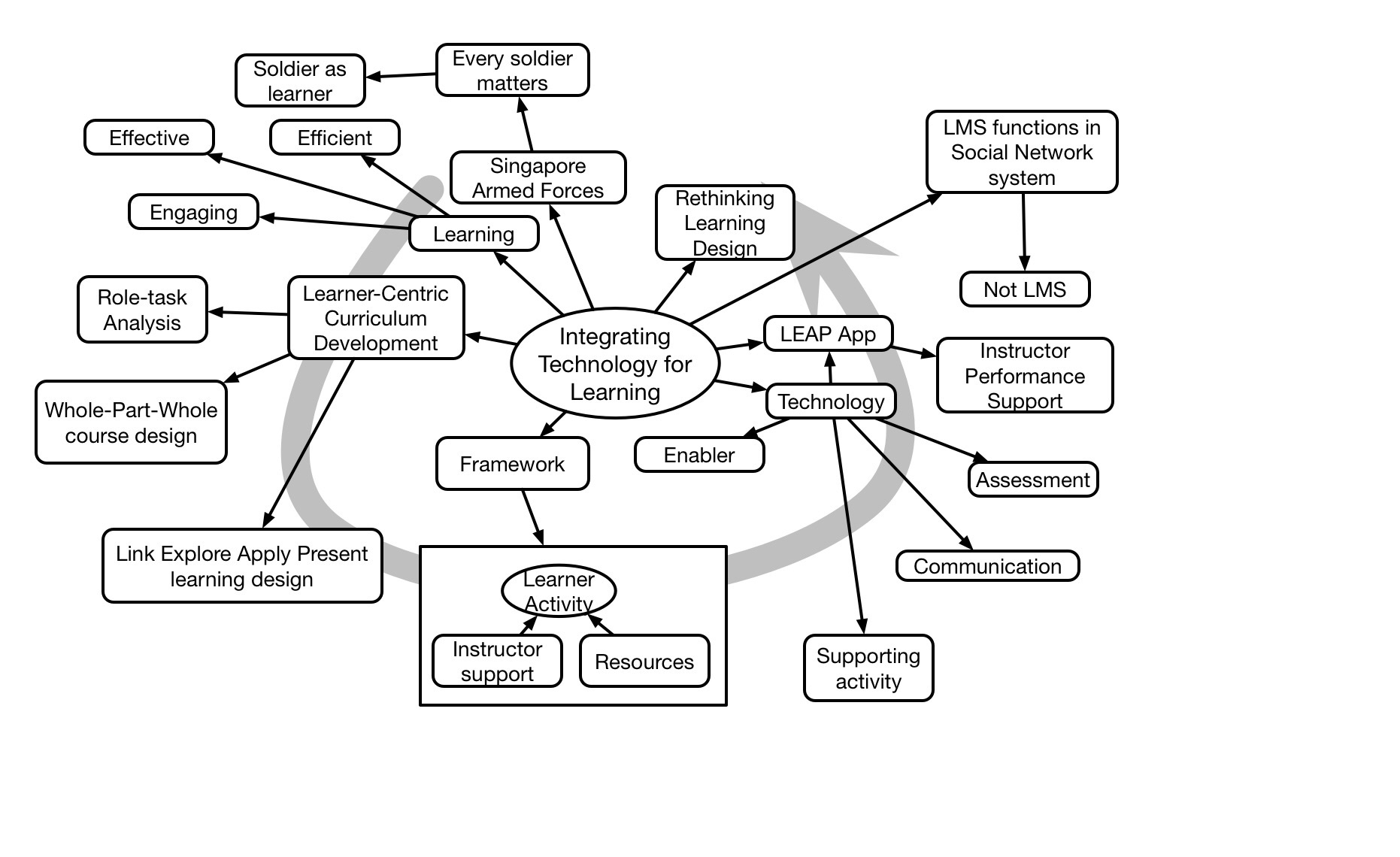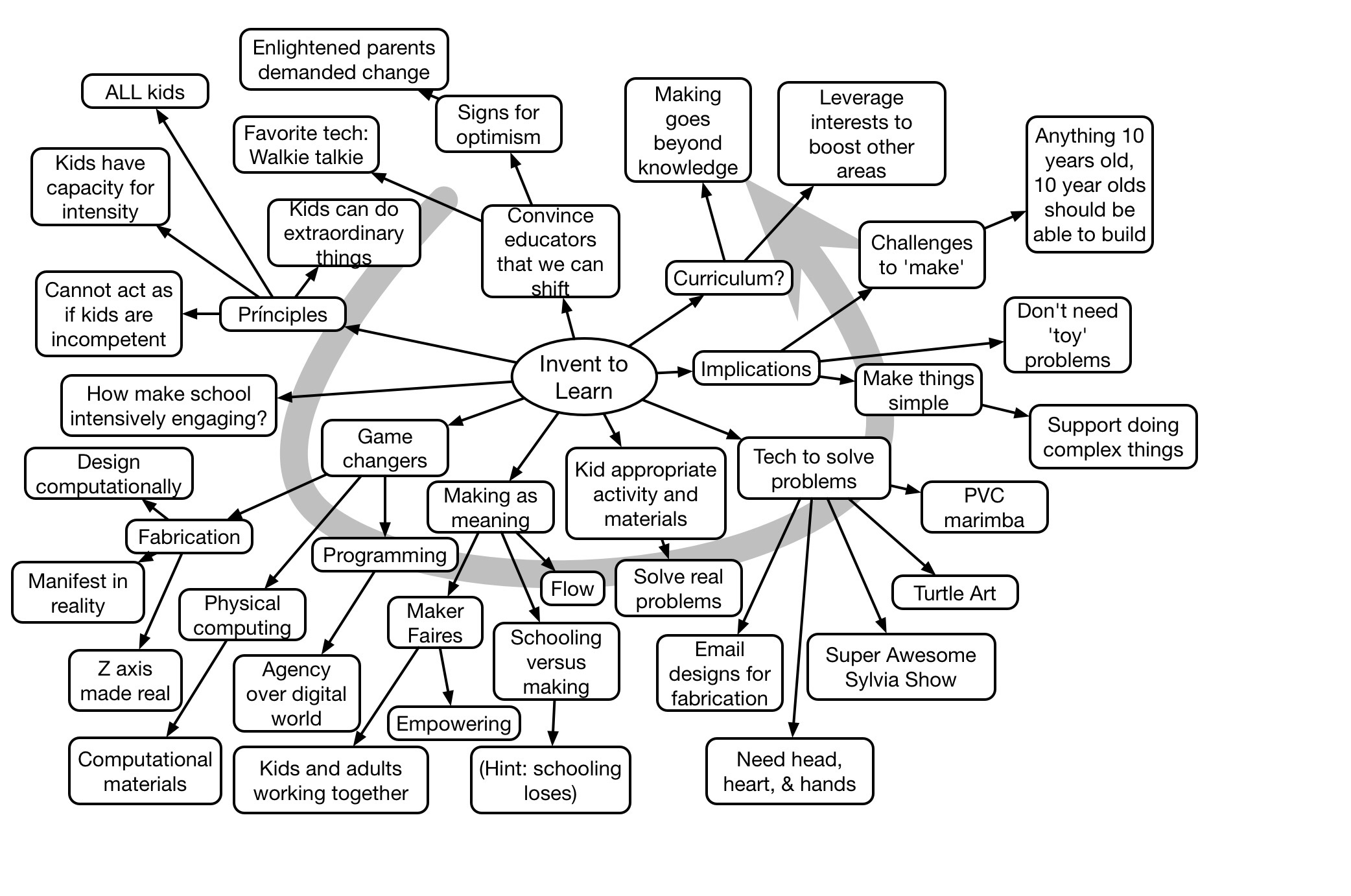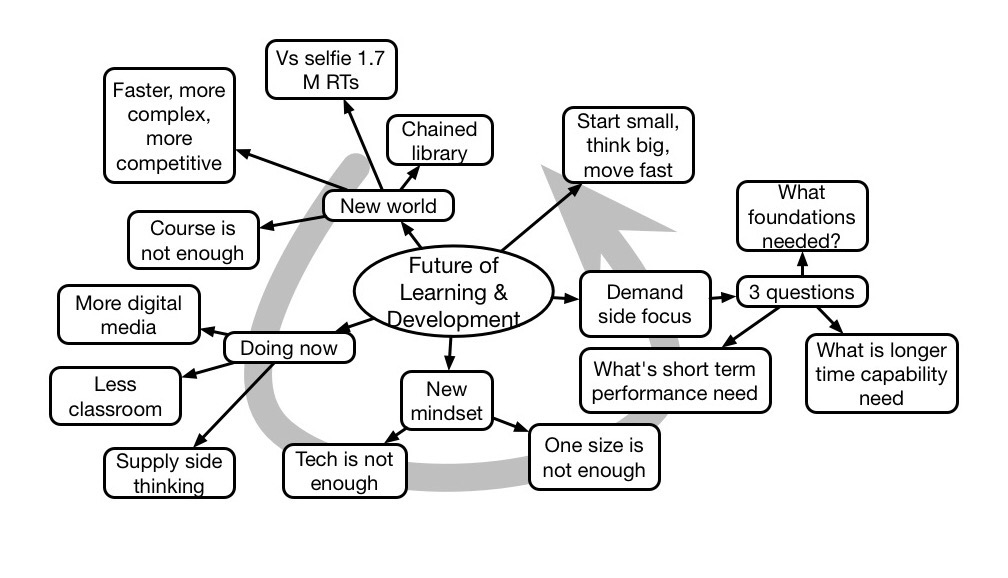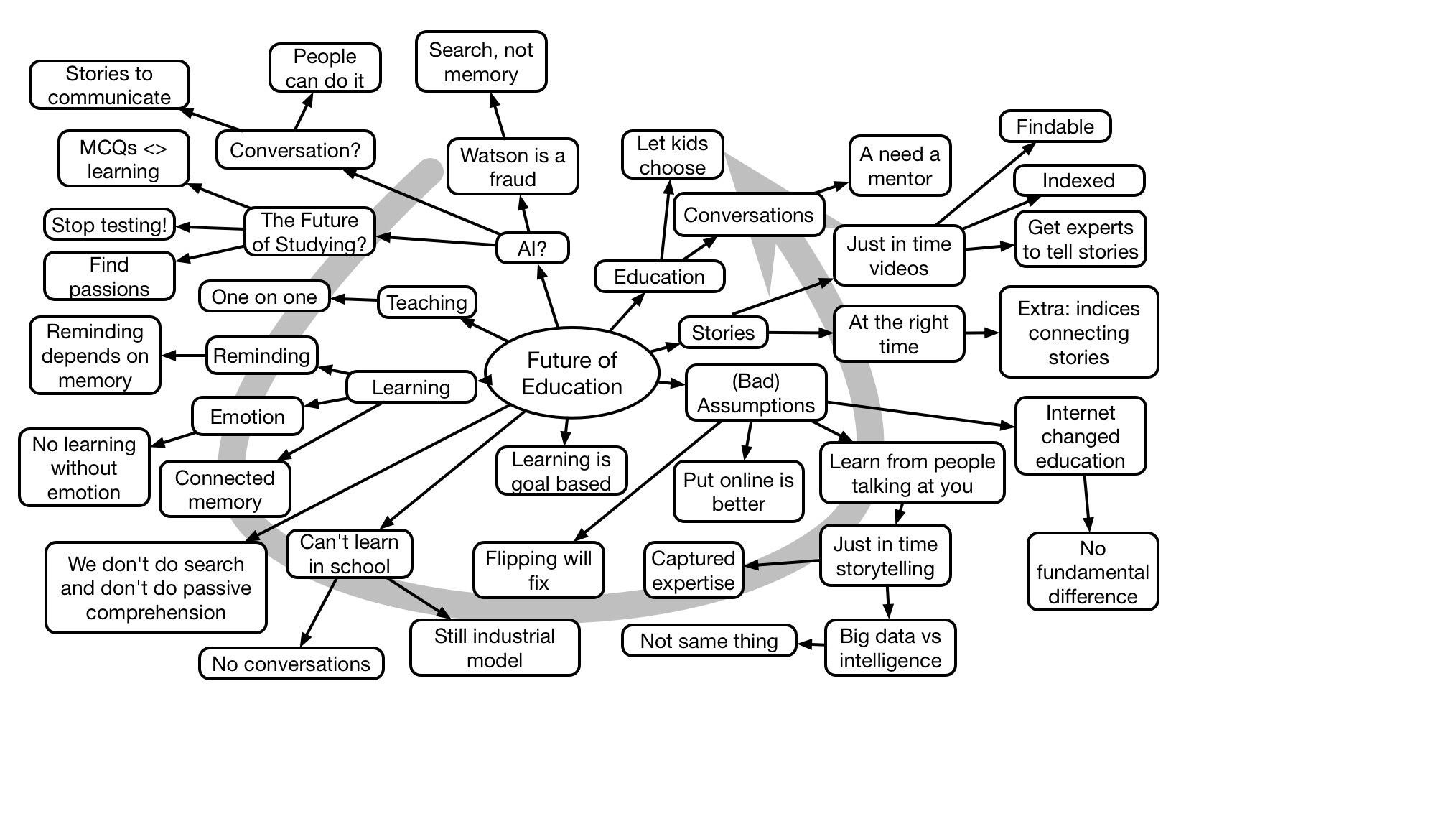Charles, in an engaging story, set the changes in work and the world as a basis for the 70:20:10 framework as a way to think about supporting learning going forward. He elaborated the elements and the value to be uncovered via examples.
Ho Mee Yin #LearnTech Keynote Mindmap
Nuancing Engagement
I‘ve talked in the past about the importance of engaging emotionally before beginning learning. And I‘ve talked about the importance of understanding what makes a topic intrinsically interesting. But I haven‘t really separated them out, as became clear to me in a client meeting. So let me remedy that here.
I‘ve argued, and believe, that we should open up learners emotionally before we address them cognitively. Before we tell them what they‘ll learn, before we show them objectives, we should create a visceral reaction, a wry recognition of “oh, yes, I do need to know thisâ€. It can be a dramatic or humorous exaggeration of the positive consequences of having the knowledge or the negative consequences of not. I call this a ‘motivating example‘ different than the actual reference examples used to illustrate the model in context. In previous content we‘ve used comics to point out the problems of not knowing, and similarly Michael Allen had a fabulous video that dramatized the same. Of course, you also have a graphic novel introduction of someone saving the day with this knowledge. It of course depends on your audience and what will work for them.
Another story I tell is when a colleague found out I did games, and asked if I wanted to assist him and his team. The task was, to me and many, not necessarily a source of great intrinsic interest, but he pointed out that he‘d discovered that to practitioners, it was like playing detective. Which of course gave him a theme, and a overarching hook. And this is the second element of engagement we can and should lever.
Once we‘ve hooked them into why this learning is important, we then want to help maintain interest through the learning experience. If we can find out what makes this particular element interesting, we should have it represented in the examples and practice tasks. This will help illuminate the rationale and develop learner abilities by integrating the inherent nature of the task into the learning experience.
Often SMEs are challenging, particularly to get real decisions out of, but here‘s where they‘re extremely valuable. In addition to stories illustrating great wins and losses that can serve as examples (and the motivating example I mentioned above), they can help you understand why this is intrinsically interesting to them. They‘ve spent the time to become experts in this, we want to unpack why this was worth such effort. You may have to drill a bit below “make the world a better placeâ€, but you could and should be able to.
By hooking them in initially by making them aware of the role of this knowledge, and then maintaining interest through the learning experience, you have a better chance of your learning sticking. And that‘s what we want to achieve, right?
Gary Stager #LearnTech2015 Keynote Mindmap
Abhijit Bhaduri #LearnTech2015 Keynote Mindmap
Abhijit used an unusual presentation deck of 2 sketch notes to present his very interesting thoughts and examples of living in perpetual beta, concluding that if L&D changes, it could be a catalyst for change. A message very synergistic with the Revolution ;).
Donald Taylor #LearnTech2015 Keynote Mindmap
Roger Schank #learntech2015 Keynote Mindmap
Non-invasive Brain Surgery
Changing behavior is hard. The brain is arguably the most complex thing in the known universe. Simplistic approaches aren‘t likely to work. To rewire it, one approach is to try surgery. This is problematic for a several reasons: it‘s dangerous, it‘s messy, and we really don’t understand enough about it. What‘s a person to do?
Well, we do know that the brain can rewire itself, if we do it right. This is called learning. And if we design learning, e.g. instruction, we can potentially change the brain without surgery. However, (and yes, this is my point) treating it as anything less than brain surgery (or rocket science), isn‘t doing justice to what‘s known and what‘s to be done.
The number of ways to get it wrong is long. Information dump instead of skills practice. Massed practice instead of spaced. Rote knowledge assessment. Lack of emotional engagement. The list goes on. (Cue the Serious eLearning Manifesto.) In short, if you don‘t know what you‘re doing, you‘re likely doing it wrong and are not going to have an effect. Sure, you‘re not likely to kill anyone (unless you‘re doing this where it matters), but you‘ll waste money and time. Scandalous.
Again, the brain is complex, and consequently so is learning design. So why, in the name of sense and money, do we treat it as trivial? Why would anyone buy a story that we can achieve anything meaningful by taking content and adding a quiz (read: rapid eLearning)? As if a quiz is somehow going to make people do better. Who would believe that just anyone can present material and learning will occur? (Do you know the circumstances when that will work?) And really, throwing fuzzy objects around the room and ice-breakers will somehow make a difference? Please. If you can afford to throw money down the drain (ok, if you insist, throw it here ;), and don‘t care if any meaningful change happens, I pity you, but I can‘t condone it.
Let‘s get real. Let‘s be honest. There‘s a lot (a lot) of things being done in the name of learning that are just nonsensical. I could laugh, if I didn‘t care so much. But I care about learning. And we know what leads to learning. It‘s not easy. It‘s not even cheap. But it will work. It requires good analysis, and some creativity, and attention to detail, and even some testing and refinement, but we know how to do this.
So let‘s stop pretending. Let‘s stop paying lip-service. Let‘s treat learning design as the true blend of art and science that it is. It‘s not the last refuge of the untalented, it‘s one of the most challenging, and rewarding, things a person can do. When it‘s done right. So let‘s do it right! We‘re performing brain surgery, non-invasively, and we should be willing to do the hard yards to actually achieve success, and then reap the accolades.
OK, that‘s my rant, trying to stop what‘s being perpetrated and provide frameworks that might help change the game. What‘s your take?
Showing the World
One of the positive results of investigations into making work more effective has been the notion of transparency, which manifests as either working and learning ‘out loud‘, or in calls to Show Your Work. In these cases, it’s so people can know what you’re doing, and either provide useful feedback or learn from you. However, a recent chat in the L&D Revolution group on LinkedIn on Augmented Reality (AR) surfaced another idea.
We were talking about how AR could be used to show how to do things, providing information for instance on how to repair a machine. This has already been seen in examples by BMW, for instance. But I started thinking about how it could be used to support education, and took it a bit further.
So many years ago, Jim Spohrer proposed WorldBoard, a way to annotate the world. It was like the WWW, but it was location specific, so you could have specific information about a place at the place. And it was a good idea that got some initial traction but obviously didn’t continue.
The point, however, would be to ‘expose’ the world. In particular, given my emphasis on the value of models, I’d love to have models exposed. Imagine what we could display:
- the physiology of an animal we’re looking at to flows of energy in an ecosystem
- the architectural or engineering features of a building or structure
- the flows of materials through a manufacturing system
- the operation of complex devices
The list goes on. I’ve argued before that we should expose our learning designs as a way to hand over learning control to learners, developing their meta-learning skills. I think if we could expose how things work and the thinking behind them, we’d be boosting STEM in a big way.
We could go further, annotating exhibits and performances as well. And it could be auditory as well, so you might not need to have glasses, or you could just hold up the camera and see the annotations on the screen. You could of course turn them on or off, and choose which filters you want.
The systems exist: Layar commercially, ARIS in the open source space (with different capabilities). The hard part is the common frameworks, agreeing what and how, etc. However, the possibilities to really raise understanding is very much an opportunity. Making the workings of the world visible seems to me to be a very intriguing possibility to leverage the power we now hold in our hand. Ok, so this is ‘out there’, but I hope we might see this flourishing quickly. What am I missing?






